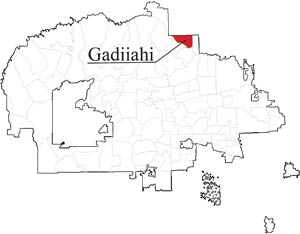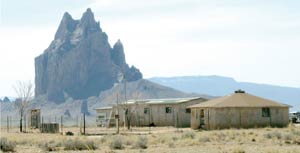The invisible chapter
Gadii'ahi/To'Koi fights for a place on the map
By Cindy Yurth
Tséyi' Bureau
GADII'AHI, N.M., April 4, 2013
(Editor's note: In an effort to chronicle the beauty and diversity of the Navajo Nation, as well as its issues, the Navajo Times has committed to visiting all 110 chapters in alphabetical order. This is the 29th in the series.)


(Times photo — Cindy Yurth)
Residents in To'Koi, one of the two main communities in Gadiiahi/To'Koi Chapter, have spectacular views of Tsé Bit'a'ii, but have no way to capitalize on the tourists that wander into town to photograph the stunning landmark, which figures prominently in the Navajo creation story. The chapter is working with the Navajo Department of Transportation to pave the road to the rock as the first step toward developing a tourist industry.
T o most people, even Navajos, Gadii'ahi is little more than a sign on U.S. Highway 64 between Shiprock and Teec Nos Pos ... crudely anglicized as "Cudei."
"Nobody even knows we're here," lamented Russell Gould, a former aide to President Joe Shirley Jr. and now community services coordinator for Gadii'ahi/To'Koi Chapter.
But if you venture off the highway for a few miles either north or south, you will find yourself in a fascinating world of sinking buildings, spectral soldiers and - most amazing of all - angelic adolescents.
At least, we assume the teens here are saintly. You won't find, boasts Gould, a single stroke of graffiti or vandalized building all the way to the Colorado line.
Gould, a transplant from Red Mesa, Ariz., figures the clue to the chapter's cleanliness can be found in its profusion of churches.
"It's a Christian community," he says, that takes its religion seriously.
But Carol Etcitty-Roger, chapter president and lifelong To'Koi resident, has a different theory. According to Etcitty-Roger, God is not the only one watching the twin towns of Gadii'ahi and To'Koi.
"There are only two or three main roads," she said, "and we're always driving on them, day and night."
If any teen was seen acting up, he'd be reported to his aunties and grandmas, and wish it was the police who found him instead of a neighbor.
The chapter consists mostly of two settlements: Gadii'ahi to the north of the highway, on the banks of the San Juan River, and To'Koi to the south, toward the Shiprock.
Gadii'ahi has some lovely farms, and To'Koi once had oil (hence its name, which translates literally as "Fire Water").
Over the years, according to Etcitty-Roger, there has been some rivalry between the two communities, with the To'Koians convinced the chapter is spending most of its resources on irrigation projects which mostly benefit Gadii'ahi. Etcitty-Roger, who hails from To'Koi, ran for chapter president to address some of those inequities, she said.
The two communities will soon be, quite literally, closer together. The chapter compound, currently located on an ancient flood plain of the San Juan, is sinking as water permeates the soft alluvial sand and creates cavities under the buildings, Gould explained.
The floor in his office in the 31-year-old chapter house visibly slopes, and the senior citizens center, built in 2000, had to be abandoned recently when it cracked right down the middle.
The chapter has withdrawn 20 acres near the highway for a new compound, and has petitioned the state of New Mexico for funds to tear the old senior center down and rebuild the center, chapter house and Head Start on the new, more solid ground.
Even in this time of budget cuts, Gould is confident Gadii'ahi/To'Koi will get at least some of the $2.6 million it asked for. Freshman state representative Sharon Clahchischilliage hails from this chapter and has been partnering with veteran state senator John Pinto, also Diné, to funnel money toward Navajo.
The proposal has already made it through the house and senate and is currently on Gov. Susana Martinez' desk.
Clahchischilliage is not the first politician from To'Koi. Her grandfather, Sam Ahkeah, was the sixth chairman of the Navajo Tribal Council, 1946-1954.
Because the discovery of oil in To'Koi in the 1920s necessitated the formation of a government to deal with the energy companies who wanted to come in and drill, "we feel like we're the start of the Navajo Nation government here," Etcitty-Roger said.
Etcitty-Roger also comes by her political bent honestly. Her father, John C. Claw, was Ahkeah's vice chairman.
These days, however, chapter politics are dominated by females here. It may be the only chapter where three of the four chapter officials - including the grazing official - are women.
The newly elected administration is getting things done, too. When the Times visited Monday, Vice President Rosie F. Frank was on the roadside in a hard hat and fluorescent vest, helping crews from the tribe and New Mexico Department of Transportation install brand new road signs for newly numbered roads.
Thanks to the efforts of Frank and Etcitty-Roger, who started the project as members of the chapter's land use planning committee three years ago, Gadii'ahi/To'Koi will be one of the first chapters on the Navajo Nation to have street addresses.
"We've gone all the way from (Highway) 491 to the state line," beamed Frank. "We're three-quarters of the way done."
Having road numbers and, later, house numbers, will hopefully ensure that the fire trucks don't race past someone's burning trailer because they can't find it, as happened to Etcitty-Roger a couple of years ago. It will also allow Gadii'ahi/To'Koi residents to have packages delivered to their front door by FedEx and UPS, pointed out Rochelle Silver-Tagaban with the tribe's Community Development Division, who is helping with the addressing project.
"I'm so proud of our community," Frank said.
That's good, because Gadii'ahi-To'Koi has been a little too modest over the years. Although the chapter boasts the dirt road that gets you the closest you can get to Tsé Bit'a'ii without walking, it doesn't advertise that fact - there's not even a sign pointing the way to the famous landmark.
The chapter has petitioned the Navajo Division of Transportation to chip-seal the road as a first step to developing a tourist industry. That should be done by the end of the summer, Gould said.
It remains to be seen how the construction will affect the ghosts. The road, known locally as "Old Soldier Road," is still used by a cavalry regiment that apparently has not heard the Indian wars are over.
You can scoff, but it's hard to find a To'Koi resident who hasn't seen or heard the ghostly regiment rumbling toward Tsé Bit'a'ii in the middle of the night. Etcitty-Roger is a believer. In fact, one of the cavalrymen once visited her house.
"My son and his friend were staying up late playing cards," she said. "It was summer, so the door was open for the breeze."
Etcitty-Roger was out of town, but when she came home her son told her a fantastic story. A dust-covered bilagáana in Union Army garb had burst into the house, wearing both a musket and a sword.
"My son said the soldier looked around with a confused expression, and left," Etcitty-Roger said. Her son, a law student, is not given to flights of fancy, she says.
People have learned to put up with the phantom regiment, but there's a little box canyon that, to this day, the locals avoid. During the Long Walk, a group of soldiers found a band of 20 or 30 Navajos hiding there, and tried to persuade them to come along peaceably.
When they refused, the story goes, they shot them dead to a man, woman and child - "even babies," whispered Etcitty-Roger.
Folks unlucky enough to find themselves near the canyon at night still hear the horrible wails of dying children.
But this is not a chapter stuck in the past. One-hundred-ninety-five acres have been withdrAwn for business development, and Gould knows he was hired on because he can navigate the tribal bureaucracy, having once been part of it.
"We need at least a gas station and a store" so people don't have to drive 15 miles to Shiprock for necessities, he said. Perhaps eventually there could be a visitor's center for the Shiprock, with a vendor village.
Gould, in fact, is urging Etcitty-Roger not to give away too many ghost stories.
"You could do one of those ghost tours," he says, only half joking.
For the moment, they're settling for the fact that, at last, people are starting to hear about their chapter. Gould has been making trips to Santa Fe to lobby for his new, more stable chapter compound.
"At first," he said, "everyone was saying, 'Gadii'ahi? Where's that?' Now it's, 'Oh look, the people from Gadii'ahi are here.'"
Gadii'ahi/To'Koi at a Glance
Name - As its name implies, the chapter consists of two communities, Gadii'ahi and To'Koi. To'Koi ("Fire Water") is named for the oil discovered there in the 1920s. The bilagáanas who came to drill for oil, however, christened the area "Rattlesnake" after the profusion of such creatures they found there. Gadii'ahi ("Juniper Tree Sticking in the Ground") is named after the only juniper tree for miles around. It's still standing near the home of Steven John, north of the chapter compound. John said his father planted the tree as a boy, but local legend has it that it washed down the San Juan during a flood and rooted here. John has taken it upon himself to care for the town's namesake, watering and fertilizing it and building a fence around it to discourage marauding animals.
Population - 550 at the 2010 Census; Chapter President Carol Etcitty-Roger estimates it closer to 1,200.
History - After the Long Walk, returning Navajos built a canal from the San Juan River to farm the valley here, growing melons, squash and corn. Recently alfalfa has been added as a cash crop. To'Koi is considered by its resident the birthplace of the Navajo tribal government, since it was the discovery of oil here that precipitated the formation of the tribal council. Gadii'ahi/To'Koi is one of the Navajo Nation's newest chapters, having split off from Beclabito in 1978.
Assets - the San Juan River, oil, proximity to the Shiprock pinnacle, a clean and safe community
Problems - Sandy alluvial soil is good for planting, bad for building. The chapter compound is sinking. Also, a pesky U.S. Cavalry regiment that refuses to leave even though they are long dead.
Famous sons and daughters - Former tribal chairman Sam Ahkeah and vice chairman John C. Claw, current New Mexico State Rep. Sharon Clahchischilliage

